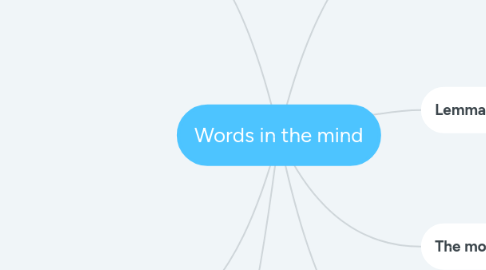
1. Mental lexicon vs. Dictionary
1.1. Mental lexicon
1.1.1. is dynamic
1.1.2. conceptual elements
1.1.2.1. context and the situation
1.1.3. human word store
1.1.3.1. capacity is not limited
1.2. Dictionary
1.2.1. is static
1.2.2. capacity is limited
1.2.3. is equally accessible
2. Lemma and Lexeme
2.1. Expression
2.1.1. is phonetic and graphematic knowledge
2.2. The grammatical and semantic side
2.2.1. syntactic and semantics information
2.3. ToT phenomenon
2.3.1. access to semantic information
2.3.2. no access to phonetic information
3. The modular model
3.1. Developed by Franz Joseph Gall
3.2. The human mind is divided into modules
3.2.1. separate and independent systems
3.3. neural architecture is responsible for the linguistic processing of language
4. Connectionism
4.1. the human processes information through networked
4.2. Learning here is based on a modification the weighting of the connections
4.3. cognition
4.3.1. central nervous system
5. How are words stored in the mind?
5.1. Fixed or fuzzy meanings?
5.1.1. The assignment of lexemes nd their corresponding semantics
5.1.1.1. be fixed or fuzzy
5.2. Prototype theory
5.2.1. meaning to belong to a category
5.2.1.1. meaning to the prototypical semantic concept
5.2.2. Prototypes are individually different
5.2.2.1. because we identify objects our own
5.2.2.1.1. through
5.2.2.1.2. perception
5.2.2.1.3. knowledge that we have
5.3. Semantic fields
5.3.1. Coordination
5.3.1.1. words which cluster on the same level of detail
5.3.2. Collocation
5.3.3. Superordination
5.3.3.1. Cover term, which included the stimulus words
5.3.4. Synonymy
5.3.4.1. word with the same meaning as the original word
5.4. Set model theory
5.4.1. Developed by Katz and Foder
5.4.2. Every word has a core meaning
5.4.2.1. many semantic features
6. The organization of the mental lexicon
6.1. Words sound structure in the mental lexicon
6.1.1. word forms are stored primarily
6.1.1.1. auditory images
6.2. The speech model of Levelt
6.2.1. Distinguishes between processes, knowledge and lexicon
6.2.2. Speech processing
6.2.2.1. conceptualisator, formulator and the articulator
6.2.3. Preverbal messages
6.2.3.1. processed syntactically
6.2.3.2. encoded phonologically
6.3. The spreading activation model
6.3.1. Words are represented as nodes
6.3.1.1. activated or inhibited by excitatory or inhibitory signals
6.3.2. The nodes
6.3.2.1. are connected by
6.3.2.1.1. semantic
6.3.2.1.2. phonological
6.3.2.1.3. associative information
